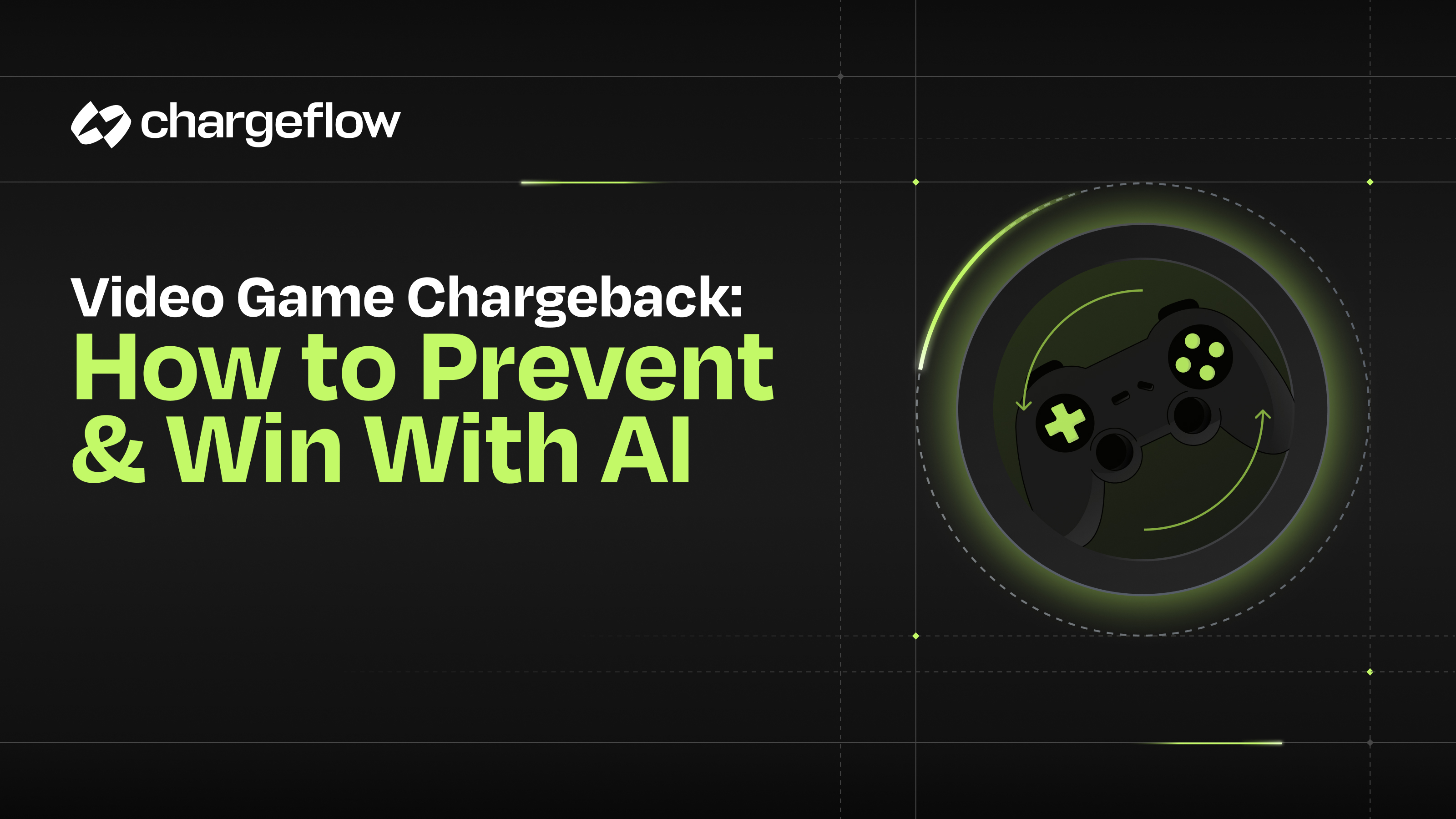Ultimate Guide to MasterCard's Excessive Chargeback Monitoring Program in 2025

Chargebacks?
No longer your problem.
Recover 4x more chargebacks and prevent up to 90% of incoming ones, powered by AI and a global network of 15,000 merchants.
Mastercard’s chargeback monitoring programs, broken into Excessive Chargeback Merchant (ECM) and Excessive Fraud Merchant (EFM), are pivotal for eCommerce merchants facing rising fraud and chargeback risks. Exceeding thresholds can trigger fines, processing limits, or payment termination.
Mastercard's chargeback monitoring program has become a make-or-break system for online merchants.
As eCommerce fraud intensifies and chargeback rates climb, exceeding Mastercard's monthly threshold can trigger this corrective measure. Merchants who enter the chargeback monitoring program face significant fines, processing restrictions, or even total payment termination.
However, prudent merchants view the Mastercard chargeback monitoring program as more than a compliance standard. Merchants who master chargeback threshold management deploy advanced dispute prevention and maintain proactive chargeback resolution. That gives them a competitive edge. They not only sidestep punitive penalties, but they also secure revenue streams.
With chargeback regulations tightening, understanding this monitoring program helps you thrive despite evolving fraud tactics.
Understanding the Mastercard Chargeback Monitoring Program
Mastercard established the Acquirer Chargeback Monitoring Program (ACMP) under its Global Compliance Programs to track merchants' monthly dispute thresholds based on chargeback count and ratio. The program requires merchants to lower their chargeback rates to stay compliant with Mastercard's thresholds and avoid penalties.
The goal? To preserve the integrity of the payment system.
Mastercard operates two distinct chargeback monitoring programs:
- Excessive Chargeback Program (ECP)
- Excessive Fraud Merchant (EFM) program
Each of these programs has varying consequences for merchants (and their payment processors). We’ll first review the ECM track before diving deep into EFM to help you understand how to avoid triggering the threshold:
1) Excessive Chargeback Program (ECP)
Mastercard's Excessive Chargeback Program (ECP) is a regulatory instrument that monitors disputes based on a Merchant Identification Number (MID). Mastercard calculates chargeback threshold using network-wide chargeback data from all transaction types, including card-present and card-not-present sales, to track chargebacks.
They monitor specific chargeback levels and the calculated basis points. The card network then alerts the acquirers if any MID surpasses the predefined compliance threshold.
ECP Formula
Mastercard determines a merchant’s ECP basis point or chargeback rate using the formula below:
- Chargeback Rate: The number of chargebacks received in the current month divided by the total transactions processed in the previous month, multiplied by 100.
- Example: 150 first presentment chargebacks in July ÷ 7,500 transactions in June x 100 = 2% Chargeback Rate.
- Chargeback Basis Point: First presentment chargebacks in a calendar month divided by the number of Mastercard transactions processed in the preceding month, multiplied by 10,000.
- Example: 150 first presentment chargebacks in July ÷ 7,500 transactions in June x 10,000 = 200 Basis Points.
Mastercard has established two levels of excessive chargeback severity based on the above formula. These are:
a) Excessive Chargeback Merchant (ECM)
Excessive chargeback merchant flags merchants with 100-299 chargebacks and a chargeback-to-transaction ratio of 1.5%-2.99% (150-299 basis points).
Mastercard applies the ECM designation to merchants who have exceeded the stated threshold for two months. However, a single month above the ECM threshold may lead to initial flagging or monitoring. But no official status or fine is applied.
Notable ECM Numbers:
- ≥100 chargebacks per month (i.e., 100+ basis points)
- Chargeback-to-transaction ratio ≥1.5%
- Non-performance assessment starts over 2 consecutive or non-consecutive months
⏱️Program Duration: Minimum of 3 months to exit after exceeding ECM threshold.
b) High Excessive Chargeback Merchant (HECM)
A merchant is flagged as HECM after exceeding 300 chargeback issuances and 3% chargeback ratio. Acquirers are responsible for notifying merchants of their status and coordinating remediation. Reaching th HECM level is a more serious situation.
Notable HECM Numbers:
- ≥ 300 chargebacks per month (i.e., 300+ basis points)
- Chargeback-to-transaction ratio ≥3%
- You must exceed both concurrently to be flagged
- Non-performance assessment starts over 2 (consecutive or non-consecutive) months
⏱️Program Duration: Minimum 6-month improvement period before consideration for downgrade.
Mastercard Excessive Chargeback Program Enrollment Consequences
Breaching the ECP threshold attract significant financial and non-financial consequences, such as:
- Fees: $1,000 to $200,000 monthly fines.
- MID Flagging: Merchant ID marked for heightened scrutiny and reporting requirements.
- Acquirer Termination Risk: Banks often terminate excessive merchants.
- MATCH Listing Probability: High likelihood of industry-wide processing ban for high excessive merchants.
Mastercard Excessive Chargeback Program Extension Requests
Merchants facing ECM or HECM designation can request a 6-month extension from Mastercard to suspend fine collection. ECP extension halts immediate fine payments for up to 6 months. It provides breathing room to implement chargeback reduction strategies. It also allows merchants to continue processing transactions during improvement efforts.
The caveat?
- Your ECM/HECM status remains active throughout the extension period.
- Fines continue piling up in the background each month you exceed thresholds.
- Extensions don't reset your chargeback monitoring status, as you're still flagged.
- Extensions pause fine assessment but not necessarily acquirer risk actions like holds, reserves, and volume caps.
At extension expiration, Mastercard evaluates your chargeback performance. If you've dropped below ECM thresholds, all accumulated fines are forgiven.
But if you're still above thresholds, you immediately owe the full accumulated fine amount. This could mean owing 6+ months of penalties in one lump sum.
Thus, extensions can be lifesavers for merchants with solid improvement plans. But they're double-edged swords. Merchants who fail to reduce chargebacks during extensions face massive bills that could exceed $150,000 to $300,000 for HECM-level violations.
Excessive Chargeback Merchant Program Remediation and Exit Strategy
Mastercard requires a comprehensive remediation plan from merchants that enter the chargeback monitoring programs. This document serves two vital purposes:
1) Demonstrating your compliance commitment
2) Determining how fines will be calculated
Below are the vital components of a Mastercard chargeback monitoring program remediation action plan:
- Business Overview: Clear explanation of your merchant operations and transaction profile.
- Root Cause Analysis: Detailed breakdown of factors driving your elevated chargeback rates.
- Improvement Timeline: Specific actions implemented with exact deployment dates.
- Technology Stack: Complete inventory of active fraud prevention and risk management tools for combating chargebacks.
Exiting ECM/HECM status requires sustained improvements. You must maintain Mastercard chargeback levels below program thresholds for three consecutive months. This is not negotiable. Even a single month spike resets your exit timeline.
🔥Pro Tip Remediation Success: Strong remediation plans, such as installing chargeback alerts and dispute analytics, don't just help with compliance. They can influence Mastercard's fine assessment decisions and demonstrate a serious commitment to long-term chargeback reduction.
2) Excessive Fraud Merchant (EFM) Program
Mastercard's Excessive Fraud Merchant program is a specialized compliance initiative for card-not-present (CNP) transactions. Unlike broader chargeback monitoring, EFM monitors fraud-related chargebacks from eCommerce transactions at the merchant ID level to maintain Mastercard network integrity.
Thus, EFM exists to track and penalize merchants allowing excessive fraud on Mastercard's network. The program aims to strengthen the overall payment ecosystem while protecting legitimate cardholders from unauthorized transaction exposure.
EFM Formula: Fraud Chargeback Basis Point
Mastercard calculates your fraud exposure by comparing your monthly transaction volume in a particular month against CNP fraud chargebacks (disputes filed under Reason Code 4837: No Cardholder Authorization) in the preceding month. Only these specific fraud-related disputes count toward EFM thresholds.
That is, fraud-related chargebacks/Number of Mastercard eCommerce transactions for the merchant in the preceding month x 10,000.
- Example: 25 July fraud claims ÷ 1,200 June sales count x 10,000 = 208 Fraud Chargeback Basis Point.
EFM Threshold Criteria
Regarding Excessive Fraud Merchant threshold, Mastercard says a merchant triggers EFM classification if they meet or exceed all four of the following criteria:
- Number of eCommerce Transactions: At least 1,000 eCommerce transactions from the previous month in clearing.
- Fraud Chargeback Amount: 50,000 U.S. dollars or higher in fraud-related chargebacks.
- Fraud Chargeback Basis Points: At least 50 basis points in fraud-related chargebacks (or 0.5% fraud chargeback count to sales count ratio).
- EMV 3-D Secure (3DS) Utilization: Merchant is located in a non-regulated country and the percentage of the merchant's clearing volume processed using 3DS is 10% or lower; or
- The merchant is located in a regulated country and the percentage of the merchant's clearing volume processed using 3DS is 50% or lower.
🔥Pro Tip: 3DS threshold utilisation is contingent upon whether the merchant is located in a non-regulated or a regulated country. Non-regulated countries are countries without a legal or regulatory demand for strong cardholder authentication (e.g. US, Canada, and some European countries). Regulated countries are countries with legal or regulatory demand for strong cardholder authentication (e.g. some European and APAC countries).
Excessive Fraud Merchant Consequences
Mastercard applies a non-performance assessment when they’ve identified a merchant as an EFM for two months, which can be consecutive or non-consecutive. Below are the eligible fine assessments.
- Fines:
- Month 1: 0
- Month 2: 500
- Month 3: 1,000
- Month 4-6: 5,000/month
- Month 7-11: 25,000/month
- Month 12-18: 50,000/month
- Month 19+: 100,000/month
- Operational and Reputational Risk: EFM listing attracts increased scrutiny and restrictions from your acquirer as they also face financial penalties for failing to report or manage EFM issues.
- MATCH (Mastercard Alert to Control High-risk Merchants) Listing Risk: High probability of Terminated Merchant File placement.
⚠️Note: Unlike ECM, EFM has only one tier. Moreso, if a merchant is identified as both an excessive chargeback merchant and an excessive fraud merchant in the same violation month, only the EFM violation will apply for that month.
EFM Extension Requests
Mastercard provides an option for acquirers to file a six-month extension option on behalf of their merchants, which suspends fine collection upon approval. Throughout this grace period, merchants remain subject to EFM program monitoring, with penalties continuing to accumulate monthly for threshold violations. The accumulated fines remain suspended until the extension is completed.
Upon extension expiration, Mastercard evaluates merchant performance against EFM thresholds:
- Merchants that have reduced their fraud ratio receive complete fine forgiveness for the entire extension period.
- Merchants exceeding thresholds face immediate assessment of all accumulated penalties from the extension period.
Excessive Fraud Merchant Program Remediation and Exit Strategy
Mastercard requires merchants designated under the Excessive Fraud Merchant Program to submit a comprehensive remediation action plan. This strategic document shows your commitment to fraud reduction and could influence penalty assessments during the review process.
Below are the vital components of a Mastercard excessive fraud merchant program remediation action plan:
- Merchant Profile: Complete operational overview and transaction characteristics.
- Fraud Analysis: Detailed examination of factors contributing to elevated fraud rates.
- Mitigation Action Plan: A Comprehensive list of implemented fraud prevention measures with specific deployment timelines.
- Technology Infrastructure: A full inventory of active fraud detection and prevention systems.
Exiting EFM requires sustained compliance performance over three months. Merchants must maintain a fraud metric below program thresholds for three consecutive months before Mastercard can grant formal exit.
That said, to facilitate exit and maintain EFM compliance:
- Implement robust fraud prevention, such as full 3DS authentication or data-only transactions (which share insights with issuers without full authentication).
- Monitor fraud metrics closely, as the program resets only after the three-month compliance period.
- Implement chargeback alert to refund high-risk transactions proactively before they turn into fraud-related chargebacks.
- For MATCH listings related to EFM, there is no explicit remediation-based exit. However, listings expire after 5 years.
Excessive Chargeback Program vs Excessive Fraud Merchant
Mastercard's designed both ECP and EFM to maintain network integrity by monitoring and penalizing merchants with high-risk activity. EFM specifically targets fraud in eCommerce environments, while ECP addresses overall chargeback volumes across all transaction types.
Below is a side-by-side comparison based on the latest available details as of writing:
Proactive Strategies to Avoid ECP and EFM Enrollment
The financial and operational risks outlined above underscore a critical reality: prevention significantly outweighs remediation when managing Mastercard's monitoring programs. Rather than navigating costly panelties and compliance requirements, you should prioritize threshold avoidance.
Mastercard has identified key prevention strategies that merchants like yourself can deploy immediately to maintain compliance and avoid program enrollment. These recommendations target the root causes of excessive chargebacks and fraud activity before they escalate to threshold-triggering levels.
ECP Enrollment Prevention Framework
- Analyze chargeback data (including reason codes) to uncover attack vectors. Leverage a third party solution, such as Chargeflow, to help address disputes before they turn into chargebacks.
- Establish a strict authorization strategy, such as velocity monitoring and strong Customer Authentication (SCA) (Mastercard SecureCode or Mastercard Identity Check).
- Implement an efficient risk detection tool with real-time monitoring and reporting functionalities.
- Review the billing descriptor and consider adding a customer service phone number.
- If the billing model is a subscription service, increase the frequency by which cardholders are notified of billing or change how you notify cardholders. Make it easy for cardholders to opt-out, downgrade, or cancel.
EFM Enrollment Prevention Framework
- Implement an internal fraud prevention tool or leverage a third-party solution that incorporates advanced detection capabilities.
- Establish a strict authentication strategy, such as using 3DS/Mastercard Identity Check Program, to allow issuers or Mastercard to perform cardholder authentication.
- Monitor and block suspicious merchant account login attempts to prevent fraudulent access to cardholder user accounts.
- Analyze chargeback data and fraudulent transactions cancellations to identify fraud attack loopholes.
- Educate yourself on the latest fraud prevention tools and fraud trends.
Leveraging Advanced Technology for Chargeback Fraud Prevention: A Case Study of Elementor
Elementor, a leading web development platform, recently faced significant challenges in chargeback management. The company's billing team spent 20-30 minutes on each chargeback, manually gathering evidence and uploading through Stripe or PayPal, creating delays and backlogs.
After attempting to build native software to fix the issue, which didn’t yield the intended result, the team integrated Chargeflow’s automated platform. Chargeflow instantly streamlined evidence collection, submissions, and signal collection with a plug-and-play process, which takes only minutes to implement, compared to weeks or months with other providers.
Result:
Why Merchants like Elementor Embrace Chargeflow
- AI and Machine Learning Tools:
- Benefits: Pattern recognition, real-time alerts, adaptive fraud scoring
- Example: Chargeflow Insights for actionable analytics and predictive insights
- Pre-Chargeback Alert Systems:
- Integrates Ethoca Alerts, Verifi CRDN into Integrate workflows
- Multi-channel notifications for fast dispute resolution
- Mastercard-Specific Tools:
- First-party fraud prevention (validating authentic purchases
- Automated dispute prevention and recovery, with industry-leading ROI
- Success-based pricing means you only pay for case prevented or won
Final Thoughts on Mastercard Monitoring Programs & Next Steps
Mastercard's monitoring programs aren't just compliance hurdles. They're business survival mechanisms for merchants. The difference between thriving merchants and those facing processing termination often boils down to three critical factors: Early intervention, systematic prevention, and strategic technology adoption.
With that in mind, here is an immediate action plan for merchants at various stages on the risk ladder:
Compliant:
- Track monthly ratios to avoid surprises.
- Implement 3DS authentication for CNP transactions (mandatory for EFM prevention).
- Deploy real-time fraud detection with machine learning capabilities.
- Establish a chargeback alert for dispute prevention and proactive, intentional refund.
Approaching Thresholds:
- Analyze chargeback data to pinpoint reason codes and attack vectors.
- Request forbearance discussions with your acquirer before formal enrollment.
- Implement emergency mitigation, including enhanced fraud filters, proactive refunds, etc.
- Prepare comprehensive remediation documentation now, not after program enrollment.
Already Enrolled:
Your timeline is critical. Focus on these high-impact action items:
- Deploy an automated chargeback management tool (like Chargeflow) for seamless dispute prevention and recovery.
- Enhance customer service touchpoints and billing descriptors.
- Implement advanced fraud scoring and 3DS authentication.
Every dollar invested in chargeback fraud prevention saves at least ten dollars in penalties and recovery costs. Your next move determines whether you’ll be discussing growth strategies or explaining processing termination to your stakeholders.
👉Take action today. Your business sustainability depends on it! Contact us if you need help getting started.

Chargebacks?
No longer your problem.
Recover 4x more chargebacks and prevent up to 90% of incoming ones, powered by AI and a global network of 15,000 merchants.






























.png)








